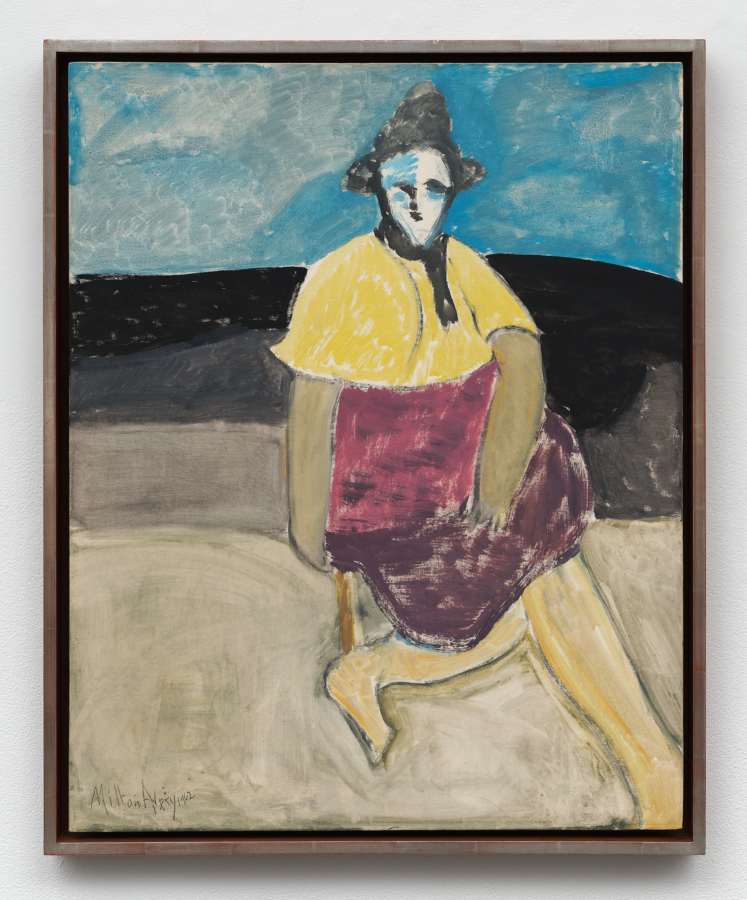Independent 20th Century Art Fair
September 7–10, 2023
Cipriani South Street
10 South Street
New York, NY 10004
Independent 20th Century Art Fair
September 7–10, 2023
Cipriani South Street
10 South Street
New York, NY 10004
For Independent 20th Century’s second edition, Karma presents an exhibition of small works from Norman Zammitt’s Band Paintings series (1973–91). This is the first solo presentation of his work in New York.
The Band Paintings comprise the largest series of Zammitt’s nearly sixty-year-long career. Each acrylic on canvas board work follows a similar logic: graphic bands of color are stacked horizontally to form a field of progressing colors. This chromatic scaling represents the artist’s attempt to capture the qualities of natural light in paint, to, in his words, “create a work which could exist on the same plane as nature, not competing but complimenting.” Inspiration came from the mystical landscapes of New Mexico, where he taught in the early 1960s, and greater Los Angeles, his home for most of his life.
Early in the series, Zammitt mixed his acrylic paint colors intuitively, but he soon found that neither his perception nor any commonly accepted color theories suited his goals. Like other Southern California artists of the period associated with the Finish Fetish and Light and Space movements, he turned to science for a solution, eventually employing scholars from Pasadena’s California Institute of Technology to develop a system of logarithmic progressions by which to blend his paint and purchasing a computer to assist with calculations. Zammitt observed that his color progression “was related to the progressional growth rates of living organisms… implying, perhaps, that life has something to do with color.”
The resulting Band Paintings use the techniques of hard-edge abstraction in service of an optically transcendent experience with color that is normally limited to fleeting moments in nature, such as when the setting sun reflects on a body of water or casts its rays from behind a mountain range. To execute the paintings, Zammitt first laid down twelve coats of monochromatic acrylic. While the stripes he applied to the prepared surface appear discrete, the hues actually overlap; through layering, he achieved their luminous, subtle color transitions. Depending on the width of the bands, which the artist considered representative of units of time, the surfaces appear to expand and contrast; while some feel grounded, others float. As curator Jane Livingston wrote in 1978, the year of his last East Coast exhibition, “Zammitt elicits light from color; the experience is of color not as clogged matter on a surface but of dematerialized prismatic light.”
Norman Zammitt (b. Toronto, Canada, 1931; d. Pasadena, California, 2017) made sculptures, paintings, and lithographs that utilize color theory to capture the mystical qualities of natural light. Zammitt was raised by a Sicilian father and a Mohawk mother in Ontario. The family then moved onto the Kahnawá:ke Reservation near Montreal, and later to Buffalo, New York, finally settling in Southern California when Zammitt was fourteen. Celebrated by John Baldessari, who taught him at the Otis Art Institute (now the Otis College of Art and Design), Zammitt was a key yet under-historicized figure in the development of Los Angeles’s Light and Space movement alongside the likes of Robert Irwin, Larry Bell, and Mary Corse. In 1964, Zammitt initiated a series of transparent, laminated rectangular sculptures, which interact with natural luminescence to create astonishing abstract visual effects. A decade later, still enthralled by the transcendental California light, he began the Band Paintings for which he is best known, a suite of ethereal works based on a logarithmic system of color progression the artist developed with the help of scholars from the California Institute of Technology. The mathematically-calculated transitions between hues of the Band Paintings smooth their hard edges into meditative spaces reminiscent of sunsets and landscapes. In the Fractal series that followed in 1988, he applied these same color theories to looser, more improvisational abstract compositions inspired by chaos theory and formally resembling the titular class of geometric forms. Zammitt employed mathematical precision in hue to spiritual ends, building a body of work which resonates optically on the wavelength of the divine.
The Palm Springs Art Museum will open the survey exhibition Norman Zammitt: Gradations in February of 2024. Other solo exhibitions have been held at the Pasadena City College Art Gallery, California (1988); Corcoran Gallery of Art (now the National Gallery of Art), Washington, DC (1978); Los Angeles County Museum of Art (1977); and Santa Barbara Museum of Art, California (1968). Notable group exhibitions include Pacific Standard Time: Crosscurrents in L.A. Painting and Sculpture, 1950–1970, Getty Center, Los Angeles (2011–12), and The Spiritual in Art: Abstract Painting, 1980–1895 (1987) and American Sculpture of the Sixties (1967), both at the Los Angeles County Museum of Art. Zammit’s work is held in the collections of the Museum of Modern Art, New York; National Gallery of Art; Hirshhorn Museum and Sculpture Garden, Washington, DC; Library of Congress, Washington, DC; San Francisco Museum of Modern Art; Los Angeles County Museum of Art; Seattle Art Museum; Norton Simon Museum, Pasadena, California; and Victoria and Albert Museum, London.



